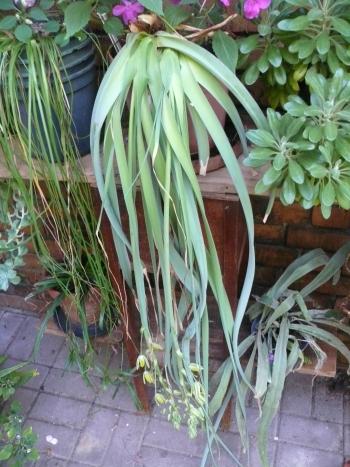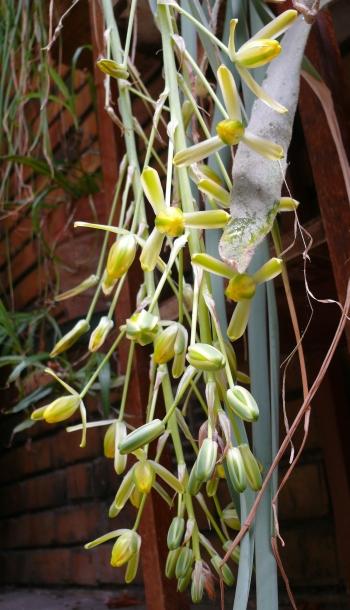Albuca deaconii
Albuca deaconii Van Jaarsv.
Family: Hyacinthaceae
Common names: yellow cliff albuca (Eng.); krans-slymstok (Afr.)
Introduction
Albuca deaconii is a solitary to cluster-forming, bulbous cliff-hanger from the southeastern Cape. The long, leek-like leaves and extended racemes, both almost a metre long, drooping from the cliff face.

Description
Description
Evergreen, bulbous plants, solitary or dividing to form small clusters, with up to 5 heads; the egg-shaped bulbs, 100–120 × 60–80 mm, growing above the ground. The bulb scales are fleshy, green, and arranged like the tiles on a roof (imbricate), withering and becoming grey, the leaf remnants persistent. The roots are fleshy, white, to about 1 mm in diameter. The firm, leathery, leek-like, grey-green leaves, 530–1130 × 30–40 mm, grow in an apical rosette. The leaves are linear, and channelled, drooping from the cliff.

The inflorescence is a spreading, pendent raceme, 320–850 mm long; the peduncle 10 mm in diameter at the base, and the raceme 130–170 mm long, with triangular, acuminate bracts clasping the pedicels. The lower bracts are larger, 42 × 17 mm, gradually becoming smaller upwards. The flowers are erectly produced, 30 mm long, yellowish green, on ascending pedicels, 55–85 mm long, becoming smaller towards the tip. The outer tepals are linear-obovate, 30 × 10 mm, yellow with a green median portion, faintly striated, the apex hooded. The inner tepals are ovate, 25 × 14 mm, with a fleshy, yellow, hinged apical appendage. The filaments are white, translucent and tapering; the outer 16 mm long, 4 mm in diameter at the base, with a constriction in lower third; the inner 15 mm long and 2.5 mm in diameter at the base. The anthers of the inner filaments are 6 × 2 mm, the outer 4 ×1 mm. The ovary is green, 10 mm long, and has a small stipe, 1 mm long. The style is yellow, linear, 3-angled, 11 × 3 mm, the stigma green, with 3 lobes. The capsule is oblong, about 18×9 mm.

Albuca deaconii flowers mainly in late spring (October and November). The seeds are normally released in early summer, towards the end of November, early December and are wind dispersed.
Conservation Status
Status
This is a recently described species and has not yet been formally assessed for the Red List of South African plants. However, the stable cliff habitat is a refuge for this species and with no known threats, it can be regarded as not threatened.

Distribution and habitat
Distribution description
Plants are only known from mineral-poor sandstone cliffs of the southern Drakensberg. According to James Deacon, it is never common, and mainly confined to cliffs, varying from shady to exposed, west- and north-facing slopes, in grassland. Associated species include Euphorbia pulvinata, Crassula ericoides and C. pellucida subsp. marginata, Ornithogalum juncifolium and the fern Asplenium cordatum. The climate in its habitat is warm temperate, with snow and frost in winter. Temperatures are mild in summer (an average daily maximum of 24–27ºC). Rainfall is mainly in summer, however, also with some in winter and ranging between 700–1 000 mm per annum.
The vegetation of the habitat of Albuca deaconii consists mainly of Amatole Mountain Grassland (Mucina et al. 2006), but according to James, plants also grow in patches of Afrotemperate Forest, but always on cliffs.
Derivation of name and historical aspects
History
Albuca was named by Carolus Linnaeus in his second edition of Species plantarum in 1762, presently consisting of more than a 100 species (Manning & Condy 2011). There is a clear centre of diversity in the southern parts of South Africa. The name Albuca pertains to the white flower colour represented in many species (Clark & Charters 2016).
Albuca deaconii was named by the author in 2013 in the bulb journal Herbertia (Van Jaarsveld 2013). It honours James Deacon, who was a horticulture student at Kirstenbosch National Botanical Garden, where he assisted the author with caring for the cliff-dwelling plants (cremnophytes) in the succulent nursery, and helped in collecting many of them. James is a keen plant explorer, has a sharp eye, especially for the smaller cliff-dwelling, bulbous plants. He is a self-taught botanist, a keen reader and fast learner. James found his Albuca deaconii, on 11 January 2011, on cliffs on his uncle’s farm, Fountain head, in the Winterberg District. It was grown in the Kirstenbosch Cliff Plant House (succulent section) and when it came into flower, it was illustrated by Jeanette Loedolff, retired botanical artist of the National Botanical Institute (presently SANBI).
Albuca deaconii belongs to the subgenus Albuca (Muller-Dobblies 1995), which is immediately recognised by the succulent hinged inner tepals and ascending flowers. The outer stamens are usually reduced, whereas the inner larger and fertile.
Albuca deaconii is related to other cliff-dwelling species of Albuca, such as A. batteniana, A. cremnophila and A. thermarum. These 3 also belong in the subgenus Albuca, all are evergreen, with pendent leaves. Albuca deaconii is at once distinguished from them by its persistent, dry, leaf bases and grey-green, leek-like (Allium porrum) leaves, and yellowish flowers that are not secundly arranged. A. cremnophila and A. batteniana have erect, secundly arranged, white flowers (secundly arranged flowers are borne along one side of the axis). The tepal tips of A. cremnophila are also yellowish. A. thermarum has shorter flowers and longer pedicels.

Ecology
Ecology
Only known from sheer cliffs in the southeastern Drakensberg. The flattish seeds are dispersed by wind and, when landing on a suitable ledge, will root quickly, becoming established. Initially solitary, later dividing. As with so many cliff-dwelling, bulbous species from dry habitats, the bulbs grow above the soil or rock, sometimes only partially covered by the substrate.
The cliff is out of reach of the large herbivores and is thus a safe refuge for the plant, where they are able to grow without disturbances such as grazing and trampling. The leaves soon become pendent, as well as the extended inflorescence. The runoff is high on cliffs and the plants have to cope with periodic dry conditions. The succulent bulb scales store sufficient amounts of water, which enables the plants to cope during dry periods.
Uses
Use
No uses have been recorded for this plant.
Growing Albuca deaconii
Grow
Albuca deaconii is easily grown in containers. It can be propagated from seed or division. Sow seed in spring or early summer, in a sandy mixture, and place in a warm protected environment. Germination is usually within 3 weeks and the young seedlings can be transplanted to individual containers, once large enough to be handled
The plant can be planted on steep embankments in gardens, in rockeries and it grows with success in hanging baskets. It can be grown on the Highveld.
References
- Clarke, H. & Charters, M. 2016. The illustrated dictionary of southern African plant names. Flora & Fauna Publications Trust, Jacana, Johannesburg.
- Linnaeus, C. 1762. Species plantarum edn. 2, vol. 1. Salvius, Stokholm.
- Manning, J.C., Forest, F., Devey, D.S., Fay, M.F. & Goldblatt, P. 2009. A molecular phylogeny and a revised classification of Ornithogaloideae (Hyacinthaceae) based on an analysis of four plastid DNA regions. TAXON 58(1):1-107.
- Manning, J. & Condy, G. 2011. Albuca spiralis. Plate 2265. Flowering Plants of Africa. 62: 30–35.
- Mucina, L. & Rutherford, M.C. (eds) 2006. The vegetation of South Africa, Lesotho and Swaziland. Strelitzia 19. South African National Biodiversity Institute, Pretoria.
- Müller-Doblies, U. 1995. Enumiratio Albucarum (Hyacinthaceae) Austro-Africanarum adhuc congniatarum. Feddes Repertorium, 106: 353–370.
- Van Jaarsveld, E.J. 2013. Albuca deaconii (Hyacinthaceae), a new bulbous species from the Eastern Cape. Herbertia 66: 146–154.
Credits
Ernst van Jaarsveld
Kirstenbosch National Botanical Garden (Retired)
Babylonstoren Farm
Extraordinary senior lecturer and researcher,
Department of Biodiversity and Conservation, University of the Western Cape
March 2019
Plant Attributes:
Plant Type: Bulb
SA Distribution: Eastern Cape, Western Cape
Soil type: Loam
Flowering season: Spring
PH: Acid, Neutral
Flower colour: Green, Yellow
Aspect: Full Sun
Gardening skill: Easy
Special Features:
Horticultural zones









Rate this article
Article well written and informative
Rate this plant
Is this an interesting plant?
Login to add your Comment
Back to topNot registered yet? Click here to register.